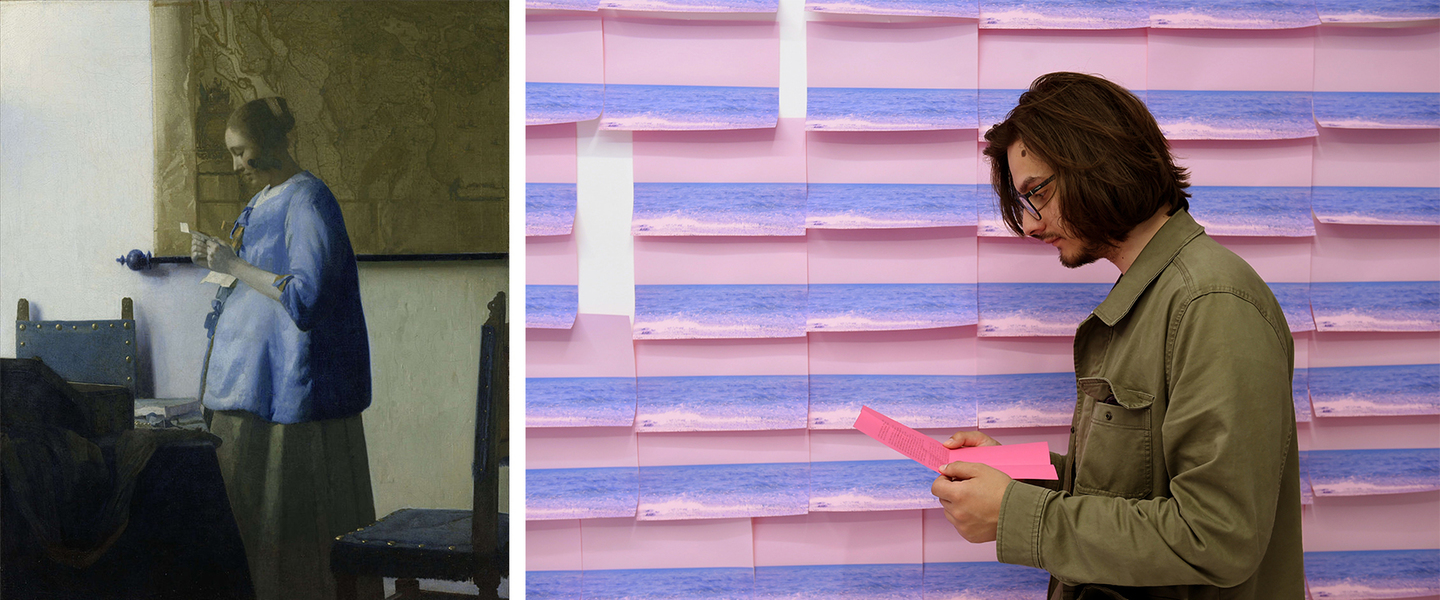About the exhibition Never Not in Love
PrivatePrint in short conversation with Darko Aleksovski about the exhibition Never Not in Love
Published on: 21.05.2019
In November 2018, during the one-day exhibition by Darko Aleksovski at the gallery of the Faculty of Fine Arts in Skopje, he has exhibited seven letters created on a typewriter. These unaddressed and never sent intimate letters, full of emotions and confessions, were placed on seven chairs and were meant to be read one by one, moving from a chair to a chair. This dynamic process that took place within the action of moving from one chair to another complemented the time and emotional dynamics of the content of the letters. Thе performative aspect of reading and the scenography were the features that defined the exhibiting character of these letters. Hence the idea to place these letters in another space with different dynamics and scenography. We talked with Darko about exhibiting this letters at PrivatePrint studio. This is how the exhibition Never Not in Love was conceived, by putting the letters into a setting created of 500 A4 format copies of a seascape photography taken by Darko during the period when the letters were being created.
Darko titled this work as Love letters of loneliness and he explains it as intimate confessions, without a possibility of them being chronologically located. They are offered to the audience to be read with the opportunity to enter into a personal world with emotional issues and situations difficult to translate into words. The series is created on a typewriter (brand UNIS tbm) and represents unaddressed and never sent letters, but directed to specific persons. The original content of the texts has been written and corrected at various times in the last two years, in the form of a diary and notes, and typed on a machine in 2018. While the ambient installation composed of numerous copies of the seascape covering the walls of the gallery, is titled Waves.
The exhibition is meant to bring the reader/observer into a visual narrative. While reading the letters or observing the dynamic installation Waves, his or her presence in the space becomes part of that visual experience.
In this brief conversation with Darko, he explains his motives, ways and thoughts to create these works.

Woman Reading a Letter by Johannes Vermeer, ca. 1663; From the opening of the exhibition Never Not in Love by Darko Aleksovski, Photography: Zoran Shekerov
Why letters and what they contain?
The letter, as an outdated mode of communication, has been selected for several reasons. The first and most obvious is the materiality of the object itself (as opposed to the ephemerality of everyday communication). Another reason is the performative aspect when reading a letter, that is, the specificity of the conditions and the time required for reading. The material background of these works is the uniqueness and unrepeatability of every text typed on a typewriter, all errors and corrections from the text itself make visual material that is almost impossible to be copied.
The text in the letters does not have a purely artistic or formal role, it does not serve as a symbol, but is a text that needs to be read. All texts are intimate confessions to specific persons, including emotions and feelings, erotic and platonic love, but also the states of loneliness and confusion, which are part of an imaginary relationship. These works as much as are addressed to real people, they also are a product of a long process of personal introspection, in which, through questions and answers, apart from revealing feelings towards certain individuals, they reveal the situations in which I have been while these feelings last.

Love Letters of Loneliness by Darko Aleksovski in the PrivatePrint Studio, Photography: Zoran Shekerov
Why pink?
The pink color in this works has a dual meaning: at the same time, the filter through which I decide to see the texts, but also the association of something organic, as layers separated from an organism, or as some kind of unveiling. The works remain in a small, standard, intimate dimension of the letter, in order to bring the audience into the position of those to whom the letters are addressed. In this sense, the performative and participatory dimension of reading is very important, that is, by opening and reading the letter, otherwise its contents remain hidden and unknown.
Hence, in formal sense, the works are shaped with pink colors and tones (a color that by definition is associated with the feminization of objects and appearance) and a typewriter (an object that in the discursive perception of professions is most often associated with women). The dichotomy masculinity/femininity, through the sign and symbolic aspects of the works, are making relation, both in the works themselves and in the relationship with the audience.

The Love Letter by Johannes Vermeer, c. 1669-1670 ; Installation Waves by Darko Aleksovski, photography: Zoran Shekerov
Why seascape?
A love letter is a fairly frequent motif in the golden age of Dutch painting from the 17th century. During this period, love was also compared to the sea, and various views of it (peaceful, turbulent, etc.) served as indicator of a particular love affair. Due to the fact that is impossibility for the viewer to read the contents of the letter, the painters often set elements with sea motifs as narrative indicators through which the viewer indirectly "reads" the contents of the letter.
In this sense, the photography in this setting is used as a narrative element, which simultaneously refers to the content of the letters themselves before they are read, but also to the Dutch painting, this time translated into a specific visual intervention.